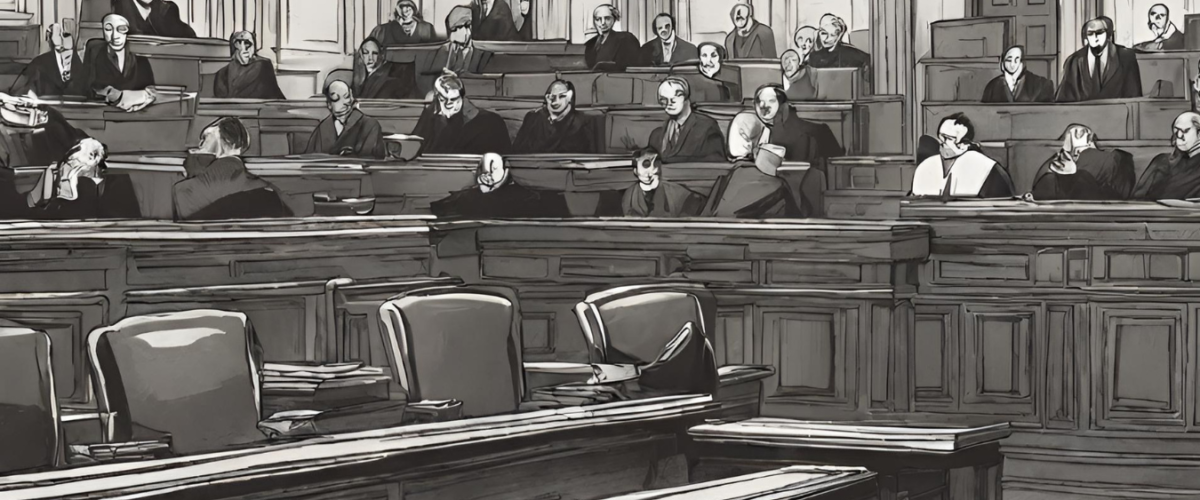This series analyses the changes proposed by the Criminal Law Bills in 2023. This article was first published as part of Project 39A’s Bharatiya Nagarik Suraksha Sanhita Bill, 2023 and Bharatiya Sakshya Bill, 2023: A Substantive Analysis, a complete version of which can be accessed here.
This post analyses the modifications in the scheme of issuing proclamations, and the implications of introducing the trial in absentia in the Bharatiya Nagarik Suraksha Sanhita
Chapter VI of the CrPC envisages a scheme of issuing summons, warrants, and notices to compel the appearance of an accused in court. If a court has reason to believe that an accused person is intentionally evading these processes, it may issue a proclamation notice and direct them to appear at a specified time and place. After issuing a proclamation notice,[1] a court may also pass an order attaching any property that belongs to the absconding accused, in order to compel their appearance in court. If they fail to appear pursuant to a proclamation notice, and they are accused of an offence specified in s.82(4) CrPC, the court may declare them as a ‘proclaimed offender’.
The BNSS proposes three modifications to this scheme. One, it clarifies the nature of offences for which an accused may be declared as a proclaimed offender (Cl.84(4)). Two, it allows courts to try proclaimed offenders in absentia, i.e., without them being personally present (Cl.356). Three, it allows courts to request for assistance in attaching properties belonging to proclaimed persons in countries or places outside India (Cl.86).
I. Proclaimed Offender under Cl.84(4)
The list of offences for which a person may be declared as a proclaimed offender under s.82(4) CrPC is restricted to certain offences under the IPC.[2] Most of these offences carry punishments of imprisonment for seven years, ten years, or with life, and as such, are grave offences.[3] However, s.82(4) does not include many other offences that carry equal or higher punishments.[4] Cl.84(4) BNSS proposes to replace the list of specified offences under s.82(4) CrPC with a sentence-based qualifier, i.e., any offence that is punishable with ten years’ imprisonment or more, with life imprisonment, or with death. The BNSS also extends the concept of proclaimed offenders to persons accused of offences punishable under any other law, in addition to the BNS.
The BNSS does not propose any other changes to the provisions related to issuing a proclamation notice or declaring an accused as a proclaimed offender. Accordingly, it retains the distinction between a ‘proclaimed person’, as someone to whom a proclamation is issued under Cl.84(1);[5] and a ‘proclaimed offender’, as someone accused of an offence specified in Cl.84(4)[6] and who fails to appear pursuant to a proclamation notice.[7]
II. Proclaimed Offenders and Trials in Absentia
In 2017, the Supreme Court suggested that procedure be adopted to conduct trials of absconding offenders in absentia, in order to remedy delays caused by their absence during trial.[8] Inter alia, High Courts of Gujarat,[9] Delhi,[10] Jharkhand,[11] and West Bengal[12] have taken different approaches to address this concern. Any attempts at codifying in absentia trials must keep in mind fair trial rights of an accused. Currently, the CrPC allows evidence to be recorded in the absence of the accused,[13] but does not provide for trials to be completed or for judgments be pronounced against absconding persons. To that extent, the CrPC strikes a balance by allowing trials to continue against apprehended accused and utilising the evidence recorded against the absconding accused during trial, while at the same safeguarding an accused’s right to defend themselves. The new procedure for conducting certain trials in absentia drastically changes this scheme.
Under the provisions of the BNSS, three conditions must be met before a court can proceed to hold a trial in the absence of the accused. One, the accused is declared a proclaimed offender under Cl.84(4). Two, they have absconded to evade trial. Three, there is no immediate prospect of their arrest. Once these conditions are met, Cl.356 deems the proclaimed offender to have waived their right to be present for their trial. After recording reasons in writing, a court may proceed with the trial as if they were present in court.
Only a proclaimed offender can be tried in absentia. Under Cl.84(4), proclaimed offenders must be accused of a grave offence, i.e., an offence punishable with imprisonment for ten years or more, life, or death. It follows that the scope of trials under Cl.356 is limited to persons accused of grave offences, at least until State governments decide to issue a notification and extend this procedure to absconders mentioned in Cl.84(1).[14] Unrestricted power to notify offences for in absentia trials is prone to misuse and may result in arbitrary State action.
The trial under Cl.356 cannot begin until ninety days after the framing of charge.[15] Offences punishable with imprisonment for ten years or more are exclusively triable by a court of sessions, and in such cases, charges cannot be framed in the absence of the accused.[16] The Bill retains this position.[17] If framing of charge is a prerequisite for trials in absentia, the scope of Cl.356 is limited to those who abscond during trial, and it excludes an accused person who has absconded during the investigation. This is consistent with the second precondition for proceeding with a trial in absentia, that the accused should have absconded to evade trial.
A proclamation can be issued if the court has reason to believe that the accused is intentionally avoiding warrants of arrest and absconding.[18] A proclamation notice must be published and affixed at a conspicuous place where the accused last resided, and the notice may also be published in a newspaper.[19] Under Cl.356(2), courts must ensure that attempts are made to inform the accused about the proposed commencement of trial.[20] It is unclear whether these procedural requirements will be understood as part of the process before issuing a proclamation notice, or as separate, additional measures to ensure that attempts are made to inform the accused of the commencement of trial. The standard format prescribed for a proclamation notice (Form No. 4) does not extend to notification of the accused about commencement of trial. A significant challenge under the CrPC is ensuring that summons, warrants, and notices are in fact issued to the accused and it is guaranteed that the accused is intentionally absenting themselves from court. The Bill does not propose any changes to address this problem.
Similar to Cl.356 BNSS, s.299(1) CrPC (retained verbatim in the BNSS as Cl.335), also requires that the accused person is absconding and there is no immediate prospect of their arrest, before evidence may be recorded in their absence. These requirements are conjunctive.[21] These requirements must be ‘proved’ to trigger Cl.335, but there is no such requirement of proof under Cl.356. It is unclear whether this is an inadvertent error, or the drafters envisaged weaker safeguards before completing a trial in the accused’s absence than for recording evidence as part of the trial. Nevertheless, both Cls.335 and 356 are a departure from the general principle that trials should be conducted in the presence of the accused, and accordingly, these provisions must be construed strictly.
The possibility of securing an easy conviction by conducting trials in absentia under Cl.356 may serve as an incentive for prosecutors and police officers to manipulate warrants and summons, or proceeding without making adequate efforts to locate the accused. Although under Cl.356(3), the accused has a right to legal counsel where they are not already represented by an advocate, no additional safeguards are provided for those aspects of the trial where the presence of the accused is indispensable. This inter alia includes the hearing under s.313 CrPC, cross examination of witnesses in the presence of the accused, and a separate hearing on sentence.
Cl.356(7) prevents filing of appeals against trials in absentia unless the proclaimed offender appears in court, and in any case, prescribes a blanket limitation of three years for all appeals against conviction in such trials. Proclamations under s.82 CrPC are understood to stand cancelled after the accused enters appearance. Should an appeal against conviction be filed, the question remains: how will appellate courts appreciate evidence collected without the presence of the accused? Appellate courts frequently remand matters where these safeguards are denied to the accused. If appellate courts regularly start remanding matters to cure irregularities in the trial and consideration of evidence against proclaimed offenders, in absentia trials may risk prolonging trials indefinitely.
Cl.356 attempts to strike a balance between two considerations: the constitutional right to a fair trial where the accused has a meaningful opportunity to defend themselves, and the overarching public interest of delivering timely justice. But in doing so, the BNSS does not propose changes to the mode of delivering summons, warrants, and proclamations. As a result, people can not only be declared as proclaimed offenders, but may now also be tried and punished, all without their knowledge.
III. Proclamation and Attachment of Property abroad
The BNSS retains the procedure under Chapter VI(C) of the CrPC for attachment, release, sale, and restoration of property belonging to proclaimed persons;[22] and introduces an important new provision, Cl.86. This provision allows a court to request a contracting state to assist with the identification, attachment, and forfeiture of a property belonging to a proclaimed person.[23] Presumably, the intention with Cl.86 is to target a proclaimed person’s property that is located in a country or place outside India. While Cl.86 stipulates that the procedure under Chapter VIII of the BNSS will apply to such requests, the procedure, scope, and purpose of attachment under Chapter VI(C) is different from attachment under Chapter VIII of the BNSS.[24]
Attachment and forfeiture under Chapter VIII relates to a property derived or obtained, directly or indirectly, from the commission of an offence.[25] Under Cl.115(2), a court must have reasonable grounds to believe that property is derived from an offence before issuing an order of attachment or forfeiture, or making a request for assistance from a contracting state in this regard.[26] Once an order for attachment or forfeiture is passed by an Indian court, enforcement of this order will depend on the relevant treaty between India and the concerned contracting state.[27] Chapter VIII of the BNSS is identical to Chapter VII(A) of the CrPC, insofar as attachment and forfeiture proceedings are concerned.[28] After considering the historical context to Chapter VII(A) of the CrPC,[29] the Supreme Court has identified two restrictions to its applicability: the property must relate to the commission of an offence, and this offence must have international ramifications.[30]
Prima facie, these restrictions do not apply to attachment proceedings under Chapter VI(C) of the CrPC. Attachment of property under this chapter is intended to compel accused persons to appear in court.[31] Any property belonging to the proclaimed person may be attached, so long as a proclamation notice has been issued validly.[32] The law does not require that the property sought to be attached be derived, obtained, or be in any other way related to the commission of any offence – and accordingly there is no requirement that a court record reasonable grounds to believe that there is a connection between the property and an offence. Chapter VIII of the BNSS additionally provides for forfeiture of property to the Central government, which is not permitted under Chapter VI of the CrPC. It is unclear why Cl.86 has been introduced in Chapter VI(C), instead of Chapter VIII.[33]
The text of the proposed addition to Chapter VI (Cl.86), does not consider the inconsistency between the purpose and procedure for attachment under Chapter VI and Chapter VIII. This raises some questions: Can a request be made to attach foreign property belonging to a proclaimed offender that is not obtained or derived from the commission of an offence, in order to compel their presence in court? Can such a request be made in relation to a proclaimed offender accused of a local offence, i.e., an offence without international ramifications? If the intention is only to attach or forfeit property obtained related to the commission of crime, on the basis of what material can a court form reasonable grounds, when the accused is absconding? Is a mere request made by a police officer (admittedly not below the rank of a Superintendent or Commissioner) sufficient? How will such requests for assistance be executed in a contracting state? Will suitable amendments be made to India’s Mutual Legal Assistance Treaties (MLATs) in this regard, or will this provision only apply to treaties ratified after the new law comes into force? In conclusion, the changes to proclaimed offenders, the addition of new procedure for trials in absentia, and the new provision permitting requests for assistance to attach property abroad raise more questions than they answer, and pose serious threat to the fair trial rights of an accused.
[1] In some cases, an order of attachment can be issued simultaneously along with a proclamation notice; See proviso to s.83(1) CrPC.
[2] S.82(4) CrPC specifies the following offences: ss.302, 304, 364, 367, 382, 392, 393, 394, 395, 396, 397, 398, 399, 400, 402, 436, 449, 459, 460 IPC.
[3] This list was retained from s.45 CrPC 1898; but the basis for selecting these offences has since been unclear. It has been argued that the list of offences was chosen arbitrarily; Abhinav Sekhri, ‘Section 82 CrPC and Proclaimed Offenders’ (The Proof of Guilt, 1 June 2015)
<https://theproofofguilt.blogspot.com/2015/06/section-82-crpc-and-proclaimed-offenders.html>, last accessed on 18.10.2023.
[4] For example, ss.121-128, s.130, s.201, ss.305–307, ss.313–316, s.326, s.326A, ss.327–329, s.366, s.376, s.377, ss.386-389, s.412, s.413 IPC are punishable with imprisonment for ten years or more, or death, but are not included within the scope of s.82(4) CrPC.
[5] S.82(1) CrPC.
[6] S.82(4) CrPC.
[7] High Courts have taken contradictory positions in this regard. Sanjay Bhandari v. State (NCT of Delhi) 2018 SCC Online Del 10203 (SJ): the Delhi High Court held that a person who is not accused of any of the offences in s.82(4) CrPC cannot be declared as a proclaimed offender. However, in Rajiv v. State of Haryana Crl. Misc. No. M-30146 of 2011, Punjab and Haryana High Court, judgment dated 12.10.2011, and Deeksha Puri v. State of Haryana, 2012 SCC OnLine P&H 20122: the Punjab & Haryana High Court held that a person to whom a proclamation is issued under s.82(1) will suffer the same liabilities and consequences attached to a person declared as a proclaimed offender under s.82(4), and the distinction between the two is only relevant insofar as the punishment under s.174A IPC is concerned. The position taken by the Punjab & Haryana High Court is an outlier. High Courts have largely agreed with the Delhi High Court’s interpretation.
[8] Hussain v. Union of India (2017) 5 SCC 702 [23]: Supreme Court flagged s.339B (‘Trial in absentia’) of the Bangladesh Code of Criminal Procedure, 1898 and requested relevant authorities to take note of the same to address delay in finishing trials.
[9] Saeed Khan, ‘Continue trial even if accused is absent: Gujarat HC to lower courts’ Times of India (11 June 2016): In 2016, the Gujarat High Court issued a circular and directed subordinate courts to proceed with trial and pronounce judgments even if undertrials were absconding; State of Gujarat v. Narubhai Amrabhai Chunara Vaghri 1996 SCC OnLine Guj 43[9]: the Gujarat High Court decided to proceed with an appeal against acquittal in their absence. The High Court also issued general directions to appoint advocates to defend respondent-accused in all similar cases where they are declared absconding.
[10] Sunil Tyagi v. Govt of NCT (Delhi) 2021 SCC OnLine Del 3597: The High Court of Delhi has issued detailed directions after a comprehensive consultative process with senior lawyers and judicial officers, but did not recommend that absconding persons be tried in absentia. The Delhi High Court issued guidelines for issuing warrants at the stage of trial and investigation, for issuance of proclamation, for enhancing the efficiency in execution of proclamations, and for early apprehension of proclaimed offenders and proclaimed persons.
[11] Hari Singh v. State of Jharkhand 2018 SCC Online Jhar 2534: In Jharkhand, the High Court requested that s.299 CrPC be amended to expedite criminal trials.
[12] Kader Khan v. State of West Bengal 2022 SCC Online Cal 1038 [36]: The High Court of Calcutta has suggested that amendments be made to the CrPC to incorporate a provision for trial in absentia, for better administration of justice and to mitigate the impact of abscondence on speedy justice and victims’ rights.
[13] S.299 CrPC.
[14] Cl.356(8) BNSS.
[15] Proviso to Cl.356(1) BNSS.
[16] Cls.249, 251(1)(b) BNSS and ss.226, 228(1)(b) CrPC.
[17] Cl.251(1)(b) BNSS: this provision requires that the accused be physically present or be produced through electronic means so that before framing any charge, the judge reads and explains the same to them.
[18] Cl.84(1) BNSS and s.82(1) CrPC.
[19] Cl.84(2) BNSS and s.82(2) CrPC.
[20] Cl.356(2)(ii–iv) BNSS: (ii) publication in a national or local daily newspaper circulating in the accused’s last known address, requiring the proclaimed offender to appear for trial and informing them that the trial will commence in his absence if he fails to appear within 30 days; (iii) informing a relative or friend about the commencement of trial; and (iv) affix information about the commencement of trial at a conspicuous part of the home where the proclaimed offender ordinarily resides.
[21] Jayendra Vishnu Thakur v. State of Maharashtra (2009) 7 SCC 104 [29].
[22] Ss.83–86 CrPC, and Cls.85, 87, 88, 89 BNSS.
[23] Chapter VIII of the BNSS retains the definition of ‘contracting state’ under Chapter VII(A) of the CrPC. See Cl.111(a) BNSS and s.105A(a) CrPC: ‘contracting State’ means any country or place outside India in respect of which arrangements have been made by the Central Government with the Government of such country through a treaty or otherwise.
[24] Barring the proposed insertion of Cl.86 in Chapter VIII of the BNSS, relevant provisions of Chapter VI(C) and Chapter VIII of the BNSS are identical to the corresponding provisions in Chapter VI(C) and Chapter VII(A) of the CrPC, respectively; see Cls. 84, 85, 87, 88, 89 BNSS and ss.82, 83, 84, 85, 86 CrPC.
[25] Cl.115(1) and s.105C CrPC; Chapter VII(A) CrPC.
[26] Cl.115(1)-(2) BNSS and s.105C(1)-(2) CrPC.
[27] See https://cbi.gov.in/MLATs-list for a list of Mutual Legal Assistance Treaties between India and other countries. Broadly, these treaties relate to requests for legal assistance in attaching or forfeiting property related to the commission of an offence.
[28] The only difference between the two chapters is the insertion of Cl.112 and Cl.113 in Chapter VIII (BNSS), which are not in Chapter VII(A) of the CrPC. These clauses are identical to s.166A and s.166B in Chapter XII of the CrPC.
[29] Chapter VII(A) was inserted in the CrPC by an amendment (Act No. 40 of 1993). While interpreting the scope of this chapter, the SC considered the Chapter heading of and the Statement of Objects and Reasons of the amending act. The Statement identified three objectives of the Amendment: ‘(a) transfer of persons between contracting states including persons in custody for the purpose of assisting in investigation or giving evidence in proceedings; (b) attachment and forfeiture of properties obtained or derived from the commission of an offence that may have been or has been committed in the other country; (c) enforcement of attachment and forfeiture orders issued by a court in the other country’.
[30] State of Madhya Pradesh v. Balram Mihani and Ors. (2010) 2 SCC 602 [13]-[18]; Ratio relied on in Shine Vijayan v. State of Kerala 2016 SCC OnLine Ker 28314; Ugma Ram v. State of Rajasthan 2022 SCC OnLine Raj 3287; Mohd. Hasheer Poolakkal v. United Arab Bank 2022 SCC Online Ker 2040; Abhay Shenikbhai Gandhi v. State of Gujarat 2015 SCC Online Guj 5964.
[31] Vimlaben Ajitbhai Patel v. Vatslaben Ashokbhai Patel and Ors. (2008) 4 SCC 649 [32]; Devendra Singh Negi v. State of UP 1993 SCC Online All 90; Daya Nand v. State of Haryana 1975 SCC OnLine P&H 200.
[32] S.83 CrPC and Cl.85 BNSS.
[33] It may be noted that certain other provisions dealing with requests for assistance from foreign courts or authorities, such as ss.166A and 166B CrPC, are proposed to be removed from Chapter XII of the CrPC [Investigation by the Police and their Powers to Investigate] and added to Chapter VIII of the BNSS as Cls.112 and 113. It is not clear whether the Supreme Court’s dicta in Balram Mihani as to the scope of Chapter VII(A) will apply to these provisions.





